No more superstorms, please. We're not quite ready.
Superstorm Sandy racked up nearly $70 billion in damages and killed more than 280 people — with more than half of those in the U.S. But one year later, business preparations for the next U.S. megadisaster remain very much a work in progress.
With more severe weather events hitting the U.S.— and likely to keep on hitting — experts say many businesses are largely unprepared to handle catastrophes and their aftermath.
"The main lesson to take from Sandy is that we've had opportunities to learn from other storms for a long time — be it storms like Katrina, Agnes, or earthquakes, fire and flooding," said Scott Knowles, a history professor and disaster planning expert at Drexel University. However, "it's not a one-time lesson. We can't just move on from the events like we're doing without being better prepared."
Even many who directly suffered through the Oct. 29, 2012, hurricane are failing to take steps to weather a storm, said Greg Wank of the accounting firm Anchin, Block & Anchin.
"We just did a survey of some 266 small businesses in the New York City area on storm preparations and less than half say they are prepared for the next one," he said. "That includes putting an emergency plan in place for workers, to having enough cash on hand to get through a business shutdown, or knowing what damage is covered by their insurance," Wank said.
Risks to infrastructure
Severe weather events put enormous stress on the nation's infrastructure, such as energy and water sources, leaving many victims in the dark without heat and even safe drinking water.
"We only lost around 2,000 customers from Sandy due to loss of power," said Jeff Sterba, CEO of American Water, which serves the Northeast.

"But the loss of electrical power meant we couldn't deliver safe, clean drinking water. We scrambled to move generators to the areas that needed power to treat and deliver water," he said.
"A storm like Sandy shows the weakness in our power grid," said Cam Dowlot of Nexans High Voltage USA, a firm that supplies products to energy companies. "You can take some preventative actions but they're never enough,"
"Power companies are doing their best to upgrade their systems by putting more cables underground instead of overhead, but it's expensive to do," Dowlot said.
After Sandy, northeastern utility Consolidated Edison is spending some $240 million to upgrade 13 power substations in New York. The company is also spending $200 million to move power lines underground.
To try to head off power losses, many businesses and homes are turning to generators.
"We've seen an increase in business," said Al Prosser, a director of sales at MTU Onsite Energy, a maker of generators.
"Sandy brought awareness to having backup power," he said. "The storm exposed flaws in electrical design and in preparedness."
"Electrical systems are more complicated now with building codes and more points of failure," Prosser added. "When a storm or earthquake strikes, they can't respond like it's normal. And people demand more power for their computers, iPads and phones."
'We prepared in advance'
Not everyone was caught flat-footed by Sandy.
"We prepared in advance after Hurricane Irene (in 2011)", said Lisa Goldstein, executive vice president and chief operating officer at the Hospital for Special Surgery in uptown Manhattan.
"We put in a series of things like submarine doors to keep the water out and moved our generators to higher floors and we had plenty of sump pumps in critical areas," she said. "And we had a huge team of employees ready for the storm."
"It does cost to do this, but it's the cost of doing business, and our patients come first," she added.
Other service providers looked for ways to improve business operations after the storm.
"We didn't lose one customer during the storm, but we did a review after Sandy and found that our own workers couldn't come into the office," said Michael Gold, president of Intermedia, a cloud services provider.
"Some of our own systems weren't available to our workers, but we've now improved the ability for them to access mobile devices," he said.
Some businesses that ignored preparations in the past are now taking them to heart.
"Before Sandy, we didn't think about storm preparation, but now we are," said John Imor, tech director for Water Quality, a marine industry insurance firm located in lower Manhattan.
"Our building flooded and the power went out. But now we changed our phone systems to where the centers are out of the Northeast," he said. "And we're putting in emergency measures to have people work in areas around their home, like a Starbucks or public library that has Internet access, if they can't get into the office," he said.
Will we forget?
Experts say getting the U.S. better prepared for severe weather is not going to be easy.
"A lot of communities are rebuilding the same way, and that's not making things better," said Illya Azaroff, chair of the American Institute of Architects for Design Risk and Recovery.
"My hope is that we will get better prepared," he said. "People are becoming more aware of storms when they happen. But will we forget their impact and ignore getting prepared before they happen? That's the question."
—By CNBC's Mark Koba. Follow him on Twitter @MarkKobaCNBC
Related stories:
Florida hurricane fund still strong at end of season
After Sandy, some NYC artists struggle to come back